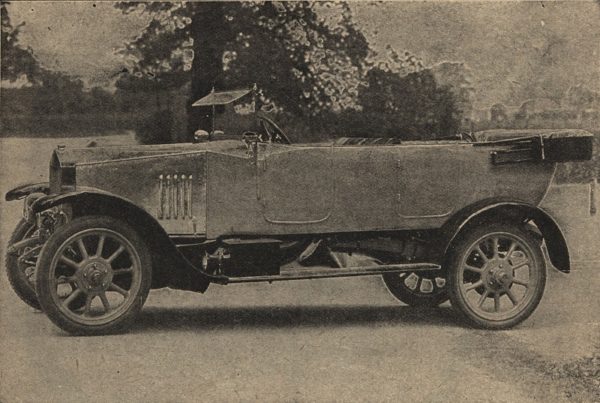
This is, in the words of Nick Georgano, an undistinguished car. But the history of its creators is far more interesting. Ernest Vernon Varley Grossmith was a member of a theatrical and perfumery company. He made his living by manufacturing mouth organs and tinned soup and by dealing in government surplus. Before the end of World War 1, in 1918, he formed the High Speed Tool Co. at a disused laundry in Acton, West London. John Robert Woods was an African river trader who had returned to England in search of more success than he had achieved in Nyasaland (present-day Malawi). Late in 1918, Grossmith dropped his Germanic name and, in partnership with Woods, started to make the Varley-Woods car in a new venture known as High Speed Motors.
The car was built from proprietary components assembled on a chassis made by Turners of Wolverhampton. The engines were whatever they could get hold of; one source states that they bought Decolonge engines from Storey in New Cross, East London – but no trace can be found of these engine manufacturers.
In 1919, after only a few cars had been made, the creditors called the bailiffs in and the laundry doors were sealed. But Varley and Woods knocked a hole in the rear of the building and removed all items of value and took them to rented buildings in Wolverhampton to continue making the car.
The new model used a 4-cylinder 1,794cc OHV Dorman engine mated to a gearbox of Varley-Woods design and manufacture. In 1920, 4-cylinder 2,303cc TYLOR engines [corrected – see comment from David Hales] replaced those from Dorman – probably because of credit problems with Dorman. Varley-Woods were advertising the 12/22 h.p. Taylor-engined car as late as September 1920, with such puffery as ‘Runs like a “Six”’; ‘Unsurpassed for Economy, Power and Flexibility’; and ‘The Only All-Steel Chassis on the Market’. But the price for the 4-seater tourer shown in our Snapshot was a steep £800, and by the end of the following month the company was unable to pay the rent on the Wolverhampton factory, and the Receiver was called in.
In total, around 150 cars were produced with Dorman engines and very few with TYLOR engines.
Ernest Varley had by this time tired of car manufacture. He sold off the family’s large country house and retired to a small cottage in Cornwall. His partner John Woods returned to Nyasaland where he was eaten by a lion.
Picture courtesy of the Richard Roberts Archive







The engines that replaced the Dorman units were made by TYLOR, who also supplied Angus Sanderson. They were not listed after 1921. At least one car survives.